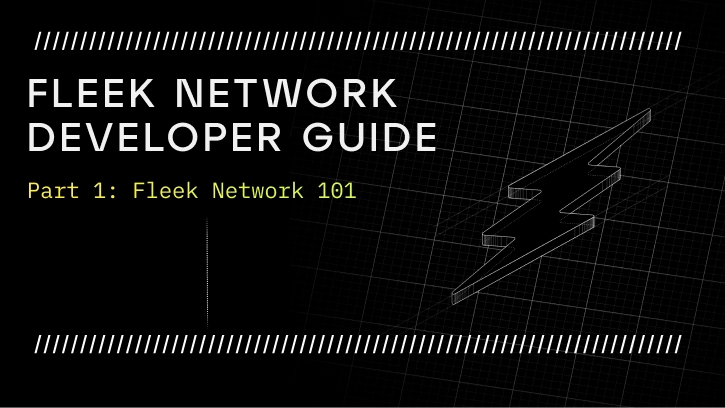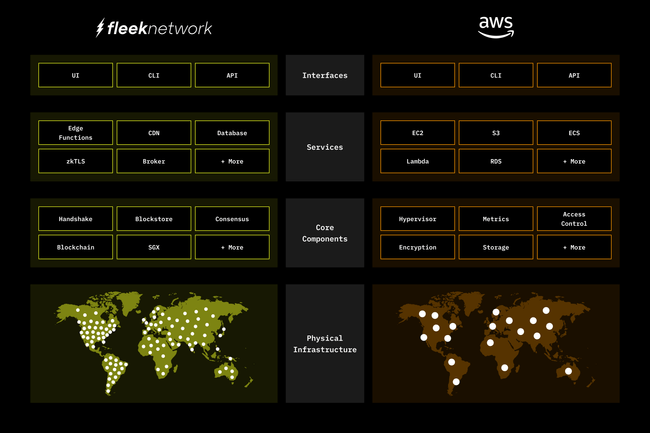Fleek Network Developer Guide Part 1: Fleek 101

As Fleek Network approaches its first official, long-running testnet (planned for late April), we thought it would be useful to start educating developers about all things Fleek Network: what it is, how it works, the problems it solves, the different ways you can leverage it, and the use cases it’s well suited for (including real examples of how developers are already planning to use it).
To accomplish this, we are starting a Fleek Network Developer Guide. We will release a new part of the guide each week, culminating in a complete developer guide to coincide with the launch of testnet.
For this first Part 1, we will cover the developer basics. Think Fleek Network 101.
Let’s dive in.
What is Fleek Network:
Fleek Network is an edge-optimized, decentralized cloud platform. Think AWS meets Uber. Fleek Network algorithmically operates a global network of web infrastructure operators (called nodes) to create a superior cloud platform for developers to run their software and applications on. Better performance, lower cost, open source, verifiable, and no central operator (meaning no corporate nonsense like confusing pricing, data abuse, censorship, deplatforming, etc.).
Building on Fleek Network also saves developers significant time by eliminating a lot of the devops and maintenance work typically required when developing on platforms like AWS. With Fleek you get permissionless, high performance, edge-optimized, auto-scalable infrastructure out of the box, and at a lower cost.
The Fleek Network Stack:

Physical Infrastructure
Unlike centralized cloud services like AWS which rely on corporate-controlled, centrally operated data centers, Fleek Network algorithmically operates a global network of web infrastructure operators (called nodes). Nodes are geographically dispersed, run by hundreds of different operators, and not vendor-locked to specific data centers. Anyone with the resources and capabilities to run a Fleek Network node is able to.
By decentralizing this layer of the stack, we are able to achieve better geographic coverage and distribution, which contributes to Fleek Network’s high performance. By running this layer of the stack algorithmically, Fleek Network is able to offer resources (cpu, bandwidth, etc.) and the web services built on top of them to developers at a lower cost.
Core Components
The Core Components level consists of logical software components containing the under-the-hood functionality that makes the Fleek Network protocol work. Core Components are essentially what represent the base protocol functionality, and they are what services interact with. Each component plays a unique role in enabling a variety of cryptographic and edge functionality within the network and services. Examples include the consensus mechanism, blockstore, fetcher, etc. Everything is open source so that any developer building on Fleek Network can verify everything going on related to or touching their code.
Expect to see a blog covering the Core Components in depth in the coming weeks.
Web Services
At the Service level in Fleek Network are composable, auto-scalable, permissionless pieces of software that come in the form of lightning-fast, edge-optimized versions of various web services most developers probably use or recognize today. This includes services like CDNs, Serverless and Edge Functions, Image Optimization, VM’s, etc. The service level is the entry point for applications to interact with Fleek Network. This is comparable to the services provided in AWS such as Lambda, S3, or EC2.
The first example of a Fleek Network service was the Edge Functions which debuted in Testnet Phase {3}. There is also a CDN service already available. Additional services will be built and rolled out by the core team and external collaborators for all developers building on Fleek Network to leverage. The core team is already collaborating with several external teams on some cool service POC’s.
Services can be used as stand-alone web services, or combined to power a wide spectrum of use cases from hosting Next.js apps to running nodes, AVS’, Provers and more.
Expect to see a full Services roadmap in the coming weeks.
Interface
Unlike AWS and other centralized cloud platforms, the interface layer of Fleek Network is unique in that it is essentially ‘headless’, meaning that there can be many interfaces for Fleek Network, which eliminates vendor lock-in. Similar to how any interface can surface and interact with any smart contract on Ethereum, any interface can surface and interact with any service on Fleek Network.
Fleek.xyz will be an open source interface making it seamless to use Fleek Network with seamless access, user management, billing, monitoring, etc. But there will be many other interfaces that surface one or many Fleek Network services either directly or indirectly.
What Can Be Built (Preview)
In Part 2 of the Fleek Network Developer Guide, we will talk all about what can be built on/with Fleek Network. But to give you a sneak peek, here’s a few services and use cases we will cover:
- Web/Edge Services
- Next.js
- Nodes
- Provers
- AVS’
- Sequencers
That’s all for now. Stay tuned for Part 2 next week.
In the meantime check out the performance results from Testnet Phase {3} (where Fleek Network deployed edge functions saw an average global TTFB 7x faster than AWS lambdas, 2.7x faster than Vercel Serverless in global testing), and start to familiarize yourself with one of Fleek Network’s Core Components, Consensus, in this engineering deep dive.
Follow along on X for the latest on Fleek Network’s rollout ⚡
- Fleek Foundation